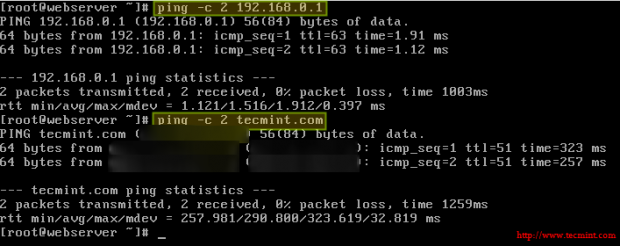In addition, NAT makes it possible that computers inside a network sends requests to outside resources (like the Internet) and have the corresponding responses be sent back to the source system only.
Let’s now consider the following scenario:

In router #2, we will move the enp0s3 interface to the external zone, and enp0s8 to the internal zone, where masquerading, or NAT, is enabled by default:
# firewall-cmd --list-all --zone=external # firewall-cmd --change-interface=enp0s3 --zone=external # firewall-cmd --change-interface=enp0s3 --zone=external --permanent # firewall-cmd --change-interface=enp0s8 --zone=internal # firewall-cmd --change-interface=enp0s8 --zone=internal --permanent
For our current setup, the internal zone – along with everything that is enabled in it will be the default zone:
# firewall-cmd --set-default-zone=internal
Next, let’s reload firewall rules and keep state information:
# firewall-cmd --reload
Finally, let’s add router #2 as default gateway in the web server:
# ip route add default via 10.0.0.18
You can now verify that you can ping router #1 and an external site (tecmint.com, for example) from the web server:
# ping -c 2 192.168.0.1 # ping -c 2 tecmint.com

Setting Kernel Runtime Parameters in RHEL 7
In Linux, you are allowed to change, enable, and disable the kernel runtime parameters, and RHEL is no exception. The /proc/sys interface (sysctl) lets you set runtime parameters on-the-fly to modify the system’s behavior without much hassle when operating conditions change.
To do so, the echo shell built-in is used to write to files inside /proc/sys/<category>, where <category> is most likely one of the following directories:
- dev: parameters for specific devices connected to the machine.
- fs: filesystem configuration (quotas and inodes, for example).
- kernel: kernel-specific configuration.
- net: network configuration.
- vm: use of the kernel’s virtual memory.
To display the list of all the currently available values, run
# sysctl -a | less
In Part 1, we changed the value of the net.ipv4.ip_forward parameter by doing
# echo 1 > /proc/sys/net/ipv4/ip_forward
in order to allow a Linux machine to act as router.
Another runtime parameter that you may want to set is kernel.sysrq, which enables the Sysrq key in your keyboard to instruct the system to perform gracefully some low-level functions, such as rebooting the system if it has frozen for some reason:
# echo 1 > /proc/sys/kernel/sysrq
To display the value of a specific parameter, use sysctl as follows:
# sysctl <parameter.name>
For example,
# sysctl net.ipv4.ip_forward # sysctl kernel.sysrq
Some parameters, such as the ones mentioned above, require only one value, whereas others (for example, fs.inode-state) require multiple values:

In either case, you need to read the kernel’s documentation before making any changes.
Please note that these settings will go away when the system is rebooted. To make these changes permanent, we will need to add .conf files inside the /etc/sysctl.d as follows:
# echo "net.ipv4.ip_forward = 1" > /etc/sysctl.d/10-forward.conf
(where the number 10 indicates the order of processing relative to other files in the same directory).
and enable the changes with
# sysctl -p /etc/sysctl.d/10-forward.conf
Summary
In this tutorial we have explained the basics of packet filtering, network address translation, and setting kernel runtime parameters on a running system and persistently across reboots. I hope you have found this information useful, and as always, we look forward to hearing from you!
Don’t hesitate to share with us your questions, comments, or suggestions using the form below.






